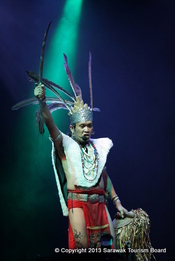From kiddy workshops, traditional crafts, spontaneous music workshops to energetic stage performances by international artistes - here are a few highlights of the one and only Rainforest World Music Festival 2016. By Mallika Naguran
Singapore 7 July 2016. The Rainforest World Music Festival (RWMF) brings together renowned world music artistes from around the world including indigenous musicians from the heart of Borneo. The all-day-long festival for all ages takes place this year from Friday 5 August to Sunday 7 August 2016 at the Sarawak Cultural Village, Santubong. Kuching, Sarawak.
The acclaimed Cimarron from Colombia will get you dancing with its rippling "joropo"!
This year’s acts include bands such as Shanren from China, Auli from Latvia, Torgeir Vassvik from Norway, Chouk Bwa Libete from Haiti, Cimarron from Colombia, Pat Thomas & Kwashibu Area Band from Ghana and many more.
A must watch gig would be Violons Barbares, which brings together a rare mix of traditions from Mongolia, Bulgaria and France. Look out for Dandarvaaching Enkhjargal on the morin khoor and jaw dropping overtone singing!
RWMF is most loved for its fun formula of interactive workshops, ethno-musical jamming sessions and mini concerts in the afternoon… prior to the actual show itself at night. To loyal fans of RWMF, the afternoon sessions are most entertaining, often making it the highlight of the festival itself.
Local and international food and drink can be purchased at the festival grounds. There will also be an arts and crafts area - get a temporary tattoo there! Buy festival memorabilia, Sarawak souvenirs and CDs by the performing artists.
Rare chance to hear rare voices and blends of traditions at RWMF, especially with Violons Barbares.
So yes, we are talking about festivity and feasts at the Sarawak Cultural Village from afternoon to past midnight. So bring lots of cash - Malaysian ringgit of course, although credit/debit cards may be accepted by certain merchants.
Something for Mom & Dad… and the Kids
There will also be fringe events to highlight Sarawak culture namely the Rainforest World Craft Bazaar and the Food and Village Mart, where one can purchase the local arts, crafts and cuisine of Borneo, as well as the Borneo Tattoo Expo at Damai Central, where one can see the traditional tribal tattoos of the indigenous tribes of Sarawak.
Look out for Pustaka Bookaroo, an event which combines music, stories and crafts from around the world for children aged between seven and 12.
RWMF Gets Bigger on Local Sounds
This year at the RWMF, eight Malaysian groups will share the stage with 26 international artistes.
Alena Murang sings as she plays the sape bringing the oral tradition of the Kenyah and Kelabit people from Ulu Baram alive.
Five artistes and groups from Sarawak will be featured, including sape maestros Alena Murang and Mathew Ngau Jau, Gendang Melayu Sri Buana, Thunder Beats of Nanyang Wushu Drums, as well as a performers from the Sarawak Cultural Village.
Two bands from Peninsular Malaysia, 1Drum.org and the Unique Arts Academy and the Band Girls of Sabah State Cultural Board will also take the stage.
“We are proud to provide a stage for our own talented performers to shine, showing that we too have leaders and groundbreakers in World Music as a genre.” says Angelina Patricia Bateman, Director of Corporate Communications, Sarawak Tourism Board and Project Director of the festival.
Local and international treats await you at this year's most unique Rainforest World Music Festival. Don't delay anymore - plan your trip today.
Visit the Official Website for more information: http://www.rwmf.net/
Visit RWMF Facebook
How to get your tickest for RWMF?
























